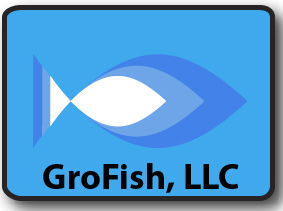See the GroFish Difference in a few hours after treatment! – Vietnam – GroFish Shrimp in Bag on Left
See the GroFish Difference the day after treatment! – Mexico – GroFish Shrimp in Right Beaker
GroFish, LLC can provide process technology to increase the efficiency of your filtration, increase the feed efficiency for your grow-out production, and provide organic methods to increase the growth rate of your raised species. We offer consultation on your feed formulations, we can treat your fry with a one-time organic treatment to enhance growth and health, and can offer markets for the sale of your products using enhanced offerings. We will customize a series of processes to help you make more money while also improving efficiencies of your production. Please see this brochure for the GroFish process and quality control.
We hold exclusive global patent rights to the proven GroFish™ treatment process. Each treatment program is designed to optimize the fish producer’s aquaculture performance, and is tailored according to the field situation for delivery of the best results for your aquatic species. We supply the staff and materials necessary for treatment.
This entirely organic process is optimized with the use of several proprietary products and processes, thereby necessitating onsite treatment by our staff. Fortunately this treatment is most effective if the aquatic species are treated once at the earliest possible age. We are able to treat as many as 25,000,000 individuals per day per technician and therefore, in most situations can be in-and-out in one day to treat your specific aquatic species needs. To learn about the GroFish application procedure, click this link.
It is imperative that water quality be maintained before, during and after the GroFish treatment to receive maximum results. Please click here for ideal water parameters.
Species to be treated can be any creature living in water. We can easily accommodate hybrid striped bass, carp, channel catfish, prawn, salmon, shrimp, abalone, trout, bullfrogs and tilapia but also mussels, clams, sea cucumbers and other aquatic species. Current research includes many new species of fresh and saltwater aquatic animals.
Field trials have proven the success of this organic treatment process and now you too can enhance your aquaculture species faster and safer. Data from previous trials indicate that aquatic animals treated with our patented process are healthier, eat more food, are more active and grow faster than untreated controls. This process does not affect the taste, but does deliver an enhanced and better-colored product when dressed-out and our specifically formulated feed is customized to provide optimal growth results. Producers may expect an increase in crop production with most species compared to their present production.
After treatment, the aquatic species treated will grow quickly. For Penaeid shrimp, it may be difficult to determine a molt (or shed) versus a deceased shrimp. Please see this guide for more information. Also, for Penaeid shrimp, special care must be taken in procuring samples for the determination of growth in GroFish treated specimens. Please see this guide regarding methodology.
Commonly asked questions:
How does the GroFish™ treatment work?
- Uses only GRAS materials as the active ingredients.
- Works on a cellular basis. Specifically at the membrane level as a single treatment done at the earliest embryonic stage.
Why does the treatment work?
- Attacks the mechanism associated with fluid and chemical transport at the cellular membrane level.
- This process of changing the cell membrane metabolism also affects the entire cell processes for the life of the cells.
- With the energetics of the cell enhanced, most of the mechanisms are sped up, therefore the animal eats more, grows faster, and hormonal production increases with consequential elevation of immunity and with increased endogenous growth hormone production as part of the effects.
- With the aquatic animal eating faster, the actual protein requirement of the feed can be decreased which not only decreases the effluent effects downstream or within the closed ecosystem but also decreases the feed costs.



